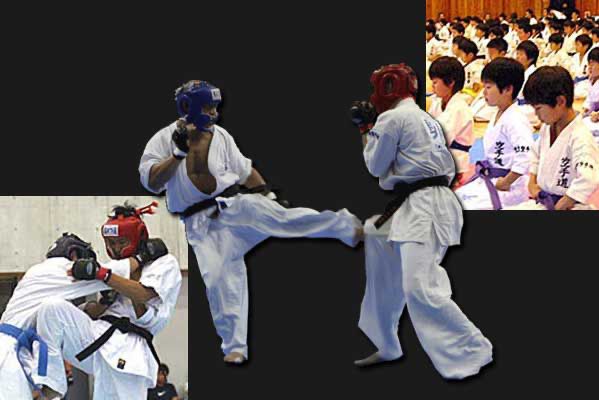Mixed martial arts matches are decided by knockout or submission using striking (punches, kicks), throwing, joint locks, and choke techniques.
Under 55 kg
Under 60 kg
Under 66 kg
Under 73 kg
Under 81 kg
Under 90 kg
Open-weight division
48 kg or less
52 kg or less
57 kg or less
63 kg or less
Open-weight division
Note:
Exceeding the weight limit at weigh-in results in disqualification.
In open-weight classes, exceeding the application weight by more than 2 kg (including clothing) results in disqualification.
In district tournaments, exceeding the weight limit by 2.5 kg (with clothing) results in disqualification with a foul.
5-minute match
No extra time
Ground Time:
1 minute 30 seconds per exchange, unlimited times
After each ground period, restart from standing position
Time continues unless stopped by the referee
Referee calls “ground” to start ground time; if fighters stand, referee calls “stand” to resume
Note:
Rule B has no overtime or re-extension.
Rule A allows one extension but no re-extension after.
Only approved karate uniforms by Zendokai are allowed (no judo or jiu-jitsu uniforms)
Members must wear designated uniforms
Boys must not wear anything under their karate top
No alterations like sleeve cutting or rolling are permitted
Wearing unauthorized or altered uniforms may result in disqualification
Mandatory Gear:
Approved headgear
Mouthpiece (bring your own)
Designated open-finger gloves
Foul cup
Optional: Women’s abdominal guard (personal use permitted)
Rules:
No modifications, deformations, or damage to the gear
Participation without proper gear is prohibited and will result in disqualification
Vaseline may be applied around the eyes for skin protection
Use of oils, fats, cosmetics, or hair products on the body or hair (excluding the face) is strictly prohibited
Vantage, taping, and supporters are generally prohibited, as is wearing anything on the hands except approved gloves
Exceptions may be granted with approval from the deputy referee or authorized tournament official
Matches are held on red and blue mats or tatami (10×10 meters), as approved by the Zendokai Technical Department
1 Referee
2 to 4 Deputy Referees
1 Auditor
Training:
All officials must complete a referee workshop hosted by the Japan Marcel Arts Federation Sri Lanka Technical Department.
Referee: Main authority on match flow and player safety
Deputy Referees: Assist in judging and ensuring fair play and safety
Auditor: Referee assistant trained in officiating; acts as advisor and consultant when judgment is unclear
Winner is determined by flag count from the auditor and deputy referees
The participant with the majority of flags wins
Deputy referees signal various match calls (e.g., technique success, fouls, out-of-bounds) using flags
The auditor assists in maintaining fair and safe match flow but does not flag except at the final decision
A win is declared under the following conditions:
Opponent is down for more than 3 seconds
Opponent loses the will to fight for over 6 seconds
Opponent submits via strangulation or joint techniques
A successful combination of two effective skills
Technical knockout declared by the main referee for safety
Opponent commits 3 fouls or is disqualified due to a serious foul
These are considered skill-based advantages but not outright wins:
Opponent is down for less than 3 seconds
Loss of fighting spirit for less than 6 seconds
Techniques stopped by the referee for safety but not considered a full win
If the match ends without a clear "one win," skill advantage, or more than 2 fouls, the result is decided by a flag judgment from:
2 Deputy Referees
1 Auditor
Judgment criteria (in order of priority):
Effective strikes and combinations
Effective aggressiveness
Ring control
The final decision is made by majority agreement after consultation
Once the match ends, the decision cannot be changed
Allowed techniques:
Striking: thrusts, kicks, knees, elbows, and headbutts (only to areas excluding head and face)
Grappling: throws, takedowns, chokes, and joint locks
Allowed techniques:
Punches to the face (excluding the back of the head)
Strangulation and joint techniques
Body strikes follow the same rules as standing attacks
Exceptions:
Under Rule B, all head and face attacks on the ground are prohibited
Under Rule A, if there's a weight difference of over 10 kg, face attacks are prohibited
Note:
Rule B has no overtime or re-extension.
Rule A allows one extension but no re-extension after.
Only approved karate uniforms by Zendokai are allowed (no judo or jiu-jitsu uniforms)
Members must wear designated uniforms
Boys must not wear anything under their karate top
No alterations like sleeve cutting or rolling are permitted
Wearing unauthorized or altered uniforms may result in disqualification
A fighter is considered in a standing state when only the soles of the feet touch the mat. If knees or hands touch the floor (e.g., after a failed tackle), it's considered a ground state.
When any body part other than the soles of the feet continuously touches the mat, the fighter is considered grounded.
If a quick transition from standing to ground causes confusion before the referee calls "ground," players must follow the rules voluntarily.
Violating attack rules—even unintentionally—is treated as a foul.
The fighting area is inside the second outer boundary of the mat. If more than half the body goes outside, the match stops and restarts from the center after a referee call ("Out-of-field foul").
If a technique naturally flows near or just beyond the boundary, the match may continue at the referee's discretion.
The referee may use commands like “Don’t move” and “Continue” to reposition fighters safely and fairly.
Fouls occur if a fighter:
Deliberately exits the field to avoid attacks or techniques
Is pushed out after multiple hits
Avoids grappling by leaving the area
Intentionally moves to an area where the match can't continue
Supporters may give verbal advice only to their own fighter
Interference with the match is not allowed
First offense = warning; second = expulsion
Serious violations result in fighter disqualification
Supporters must not:
Distract or influence the referee
Protest, insult, or act violently toward referees or opponents
Headbutts to the face, elbows
Groin attacks, biting
Attacks to the brain, spine, back of the head, or medulla
Lifting and slamming a grounded opponent (busters prohibited)
Attacks using or targeting three or fewer fingers
Grabbing hair, throat, or mucous membranes (eyes, nose, ears, etc.)
Strangulation using belts
Punches to the face on the ground with a weight difference over 10 kg
Attacks on downed opponents
Grabbing headgear or gloves
Face attacks while grounded under Rule B
Kicks to the face on the ground
Ignoring referee instructions
Unsportsmanlike behavior by supporters
Actions that disrupt the tournament
First foul: Warning ("Foul 1")
Second foul: Point deduction (unless it's a skill-based infraction)
Third foul: Disqualification
Malicious fouls: May result in immediate disqualification
All participants and supporters are expected to uphold the values of martial arts by showing respect and discipline throughout the event.

With around 15 affiliated organizations (including sub-organizations) and approximately 35 dedicated instructors, the Federation actively promotes:
The inheritance and practice of traditional Japanese martial arts
Youth development and mentorship
Organizing competitions and national tournaments
Charity and community welfare activities
Cultural exchange and international cooperation

EARN YOUR BELT—BEGIN YOUR JOURNEY TODAY!
WhatsApp us